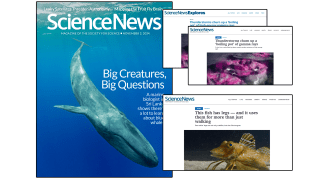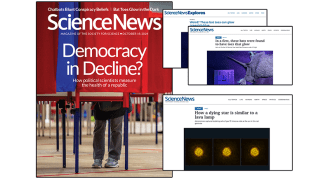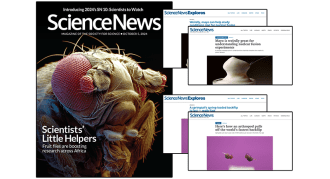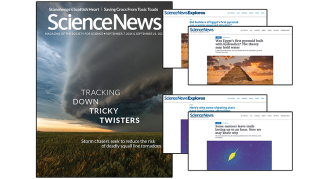Search Results
Catchy catalysts and exciting enzymes
A carnivorous plant enzyme and an enzyme from a symbiotic fungal friend expedite digestion of ants. Use this as an example of enzymes, to introduce catalysts to your students. Then have students investigate how enzymes relate to catalysts, create their own catalyst metaphor and find another example of a catalyst or enzyme. Have students share examples and, as a class, discuss why scientists are interested in learning more about enzymes or other catalysts and potential applications of catalysts.

Fish Legs and Stormy Gamma Rays
Begin a unit on natural selection using the northern sea robin before having students create their own species with adaptations specific to a unique habitat and introduce a new type of gamma ray electromagnetic radiation found from lightning with articles from the November 2 issue of Science News.
Stormy Days & Gamma Rays
Lightning crackles across roiling skies—a visible display of a thunderstorm's energy. However, these storms produce more energy than we can see. Scientists have now used new gamma-ray imaging techniques to reveal invisible energy streaming out of these natural light shows. Learn how gamma rays relate to the electromagnetic spectrum and explore the relationship between wavelength and energy, all while drawing connections to weather phenomena.
Assembly of Amazing Adaptations
To survive, creatures need to be able to sense many aspects of their environment, including food options. Scientists have recently discovered that the northern sea robin, an oceanic fish, has legs used for walking and also for tasting, to find buried meals. Begin a unit on natural selection/evolution by reviewing what these terms mean. Then, provide example organisms to explore their different types of adaptations (structural, physiological and behavioral). Finally, have students create their own species with adaptations specific to unique human- or natural disaster-influenced habitats.

Lava Lamp Star and Glowing Bat Toes
Incorporate articles from the October 19 issue of Science News to begin a unit on energy transfer by having students compare how convective cells of gas on the surface of a distant star are like a lava lamp and discuss how an experimental failure led to a surprising discovery of photoluminescent bat toes.
Convection Connections
For astronomers, watching convective cells of gas move on the surface of a distant star was kind of like looking at a lava lamp. Begin a unit on energy transfer by having students discuss lava lamps and the process of convection at work in them. Then have students read about the first observation of convection on a distant star and its potential scientific importance. Finally, students will brainstorm and diagram other examples of devices or natural processes that involve convection.
Photoluminescent Bat Toes
Biologists didn't design their experiments looking for glow-in-the-dark feet, but sometimes scientific failures yield surprising discoveries. If glowing toes sound batty to you, learn how scientists illuminate the secrets of a flighty mammal while answering questions about the scientific process.

Arthropod Olympics and Mayo Fusion
Check out recent articles from the October 5 issue of Science News to have students investigate a recent study of backflipping springtails, calculate the velocity and acceleration of springtail flips, and design their own Olympic event with another impressive arthropod. Use the comprehension lesson plan to have students learn how mayo served as a model for nuclear […]
Arthropod Olympics
A recent study found that a species of globular springtail can perform the fastest backflip of any animal on Earth. In this activity, students will research another Olympics-worthy arthropod competitor and describe how they’d measure performance in their imagined sports event.
A Nuclear-Shmear Campaign
Love mayonnaise or hate it, physicists just put this contentious condiment to work. Scientists struggle to study the behavior of matter during the process of nuclear fusion. Learn how researchers overcame some of these obstacles: They used a condiment with some surprisingly similar characteristics. It also helped them answer questions about the value of models for illustrating scientific processes.
Coral Conference
Coral reefs are one of the most biodiverse ecosystems on the planet. Along with providing food and shelter for a variety of marine organisms, coral reefs reduce erosion and protect coastal cities from storms. However, coral reefs are threatened by the effects of climate change. In this activity, students will model the complex interactions that occur within corals, their ecosystem and the Earth’s spheres to learn about how climate change harms coral reefs. After modeling how these interactions change with increasing ocean temperatures, students will brainstorm potential ways to solve or mitigate coral bleaching.

Investigating Phenomena with SEPs and Hydraulic Engineering CER
Use shooting stars as an example phenomenon to explain how phenomena are studied using the Science and Engineering Practices and have students evaluate the claim, evidence and reasoning for why hydraulic engineering may have helped ancient Egyptians build the pyramids using these lesson plans tied to articles from the September 7 & 21 issue of […]